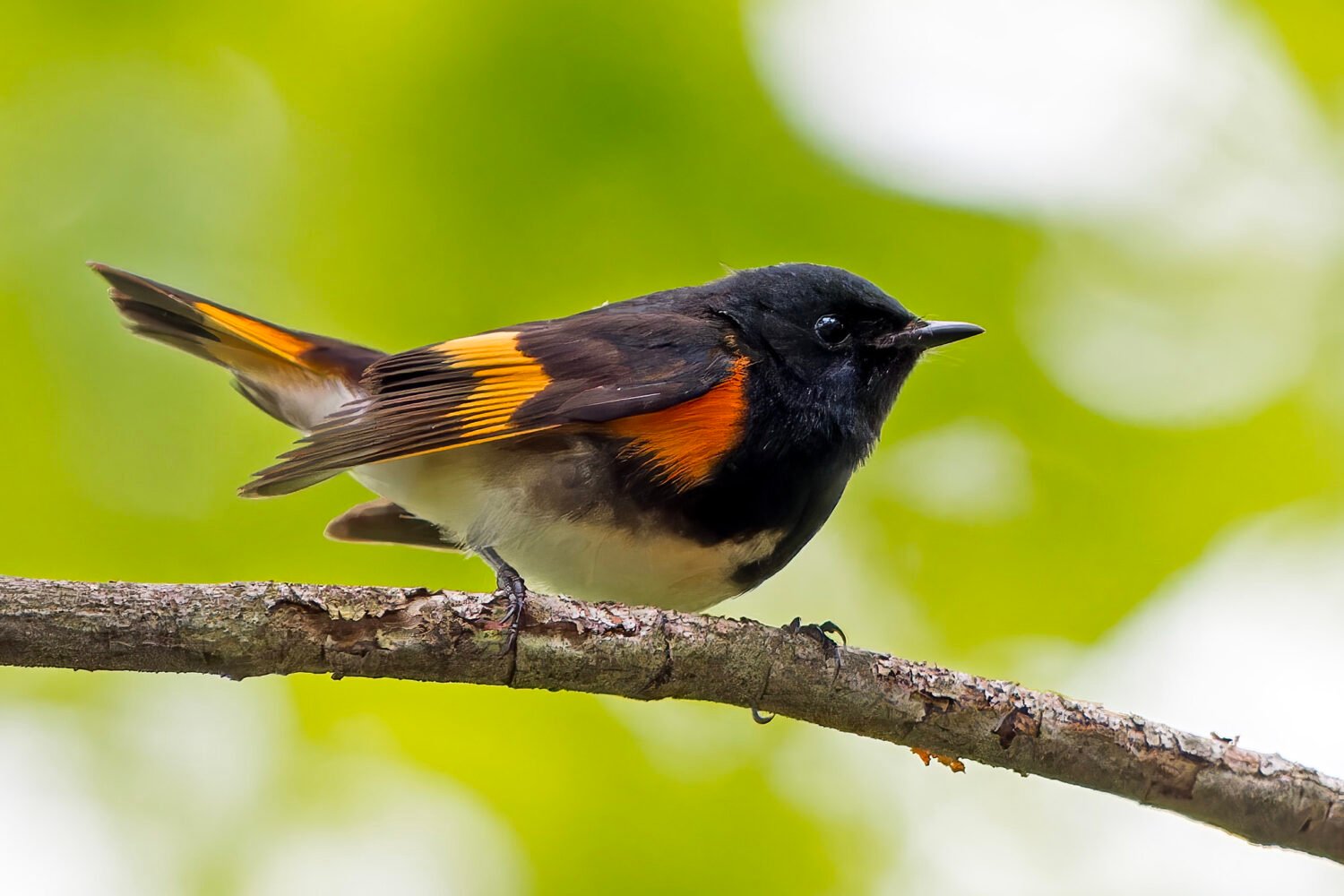It Was Late Afternoon,
Carla Dove recalls, when the lines on her telephone “started lighting up like Christmas trees.” Coworkers barged into Dove’s office on the sixth floor of the National Museum of Natural History, breathlessly reporting the news: A passenger airplane had gone down into the Hudson River in New York.
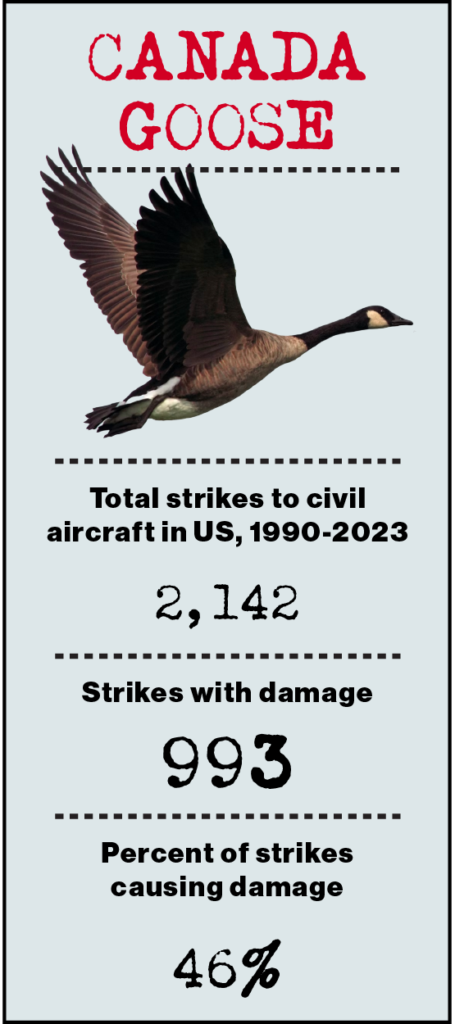
The date was January 15, 2009. As the world would later learn, a flock of birds had flown into the engines of a US Airways flight taking off from LaGuardia Airport, causing them to lose power. What happened next eventually became the basis of a Hollywood movie: Captain Chesley “Sully” Sullenberger and his copilot, Jeffrey Skiles, skillfully glided the Airbus A320 to a hard landing in the Hudson River. Everyone onboard survived.
Dove’s work was just beginning. A forensic ornithologist, she heads the Smithsonian Institution’s Feather Identification Lab, an elite, five-person unit that’s the only full-time bird-strike identification lab in the world. (Yes, her surname is Dove. Yes, she studies birds. Yes, she has already heard the joke.) Whenever birds collide with civilian or military aircraft so violently that what remains of the winged creatures is beyond recognition, Dove’s lab gets a call. The leftover gunk—feather residue, broken beaks, gut matter—is collected, then mailed to Washington. “We get degraded samples that are sometimes disgusting,” Dove says. “It’s not a very glamorous job.”
It is, however, essential. Tucked into a part of the Smithsonian that visitors usually don’t see, the domain of researchers, lab techs, and specimens kept in storage, the feather lab uses everything from DNA analysis to old-fashioned eyeballing to determine the particular species of bird remains. This isn’t simply an academic exercise. Between 1988 and 2023, wildlife strikes—the vast majority of them birds—destroyed 350 civil and military planes and killed 491 people worldwide. By figuring out which birds are most often involved, Dove and her colleagues are helping save lives—human and avian.
“Knowing what bird species are on an airfield,” she says, “is the first step in preventing these strikes from happening.”
On a Friday afternoon in March, I’m standing at a workspace in the Feather ID Lab. In front of us is a goose corpse—wings tucked in, beak tightly closed, its plump belly facing the ceiling. There are also several bags of what Dove and company call “snarge,” a mash-up of the words “snot” and “garbage,” used to describe the viscid leftovers of birds that have collided with planes.
A short woman with gray hair the shade of Meryl Streep’s, the 62-year-old Dove radiates authority and a reassuring warmth—she comes across like a favorite aunt who won’t tell on you if you admit to breaking a lamp in the house. Bird residue was not always her forte. She grew up in the Shenandoah Valley as the child of poultry farmers but usually ran for the hills when her grandmother, a woman who butchered her own chickens, busted out the cleaver.
“I wasn’t squeamish,” Dove says, speaking with a slight country twang. “Just being on a farm, you see how animals are butchered and prepared for food, but I didn’t want anything to do with it.”
Dove was the first person in her family to attend college, and later earned a master’s and a doctorate from George Mason University, where she studied the microscopic structures of feathers. As an undergraduate at Lord Fairfax Community College (now named Laurel Ridge), she studied under western Virginia naturalist Rob Simpson, who inspired her budding love of ornithology. “As a kid, I loved to watch vultures soaring around,” says Dove. “I was in tune with birds.”
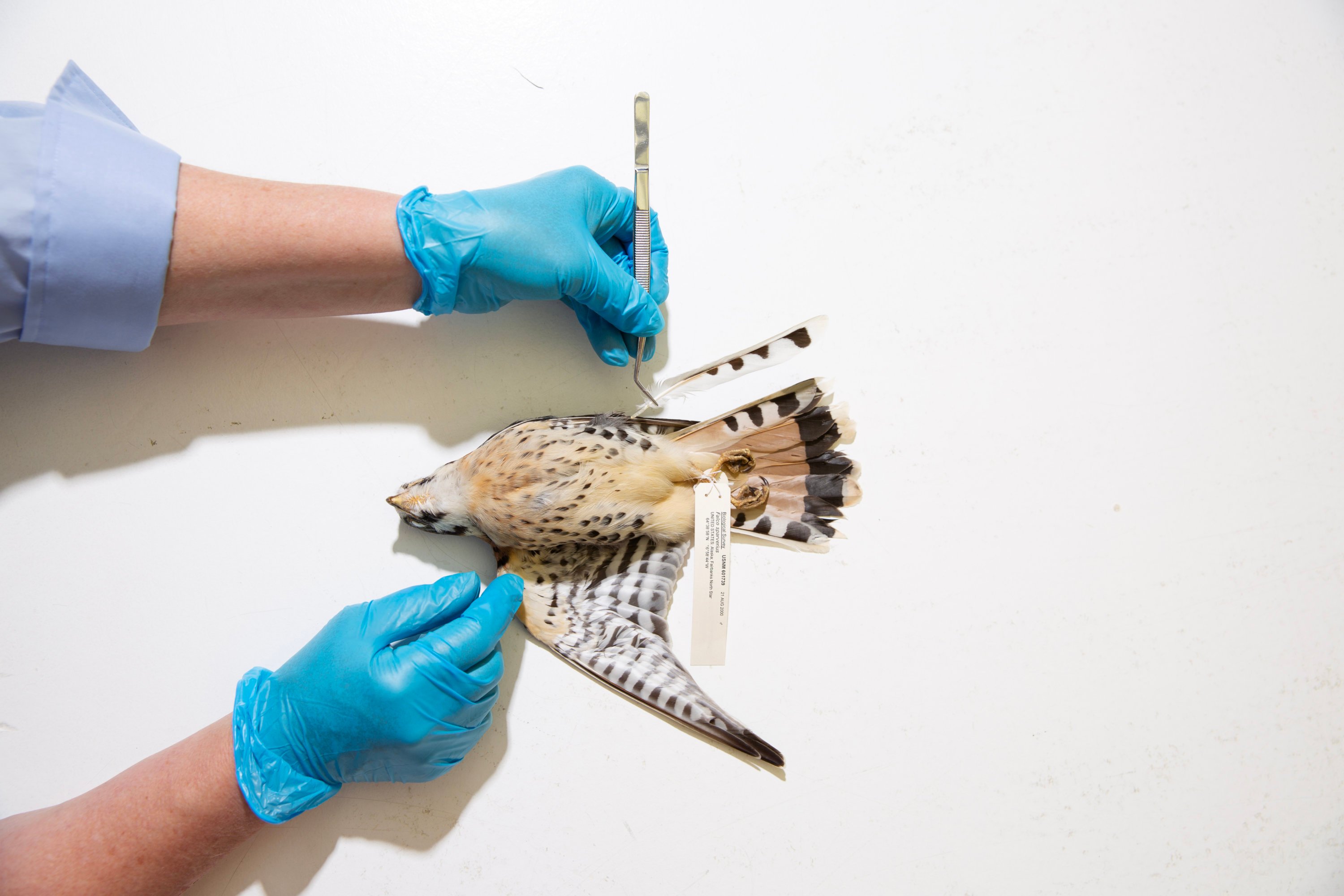
After transferring to the University of Montana, Dove landed a work-study job at a zoological museum on campus, where she finally learned how to skin a bird. For her first attempt, she picked a cedar waxwing, which has a black mask, a crest of light-brown plumage, and just a touch of yellow on its belly. Things went poorly. “You don’t have to make them look alive, but you do have to make them look clean and functional,” Dove recalls. “And my bird turned out looking like a wet piece of ick. It was like a wet rag laying on the table, and I was just so embarrassed.”
By the time Dove graduated in 1986, she was no longer turning out wet rags. She moved home and found a job at a cancer-research lab in Bethesda but kept applying for jobs at the Smithsonian, until the Museum of Natural History hired her in 1989. That’s when she met the late Roxie Laybourne.
A Smithsonian ornithologist, Laybourne essentially founded the field of forensic ornithology—that is, using bird-feather identification to further conservation efforts, build cases against smugglers and poachers, and even prosecute homicides. (In one case, Laybourne matched feathers from a victim’s down jacket to those found in the perpetrator’s van. In another, she matched feather fragments found on a bullet removed from a victim’s body with fragments from their spouse’s pillow, which had been used to muffle the sound of the gunshot.)
To Dove, Laybourne was more than a brilliant, pioneering scientist. She was a career-shaping mentor and friend. Originally from North Carolina, Laybourne was a fellow “Southern girl,” as Dove says, who shared a similar passion for the outdoors—and a smattering of other, more random interests. “We had a lot of fun together because we had a lot of stuff in common. She liked to drive fast; I like to drive fast. We both liked to drink Mountain Dews and eat cheese crackers,” Dove says with a chuckle. “And we both just loved working here and solving puzzles.”
First working for Laybourne as a technician, Dove spent her daytime hours preparing specimens and cataloging birds, then stayed late into the evening and came in on weekends to learn more about identifying them. Eventually, she took over the lab. Dove also contributed to the growth of the Smithsonian’s bird library, which currently contains 500,000 preserved bird corpses, spread across 2,400 slim filing cabinets and representing 8,500 species.
Accounting for approximately 85 percent of the world’s diversity of birds, the library is a scientific marvel, routinely visited by researchers. But as more and more airplanes crowd our skies—striking an increasing number of birds—it has become something else: an indispensable tool.
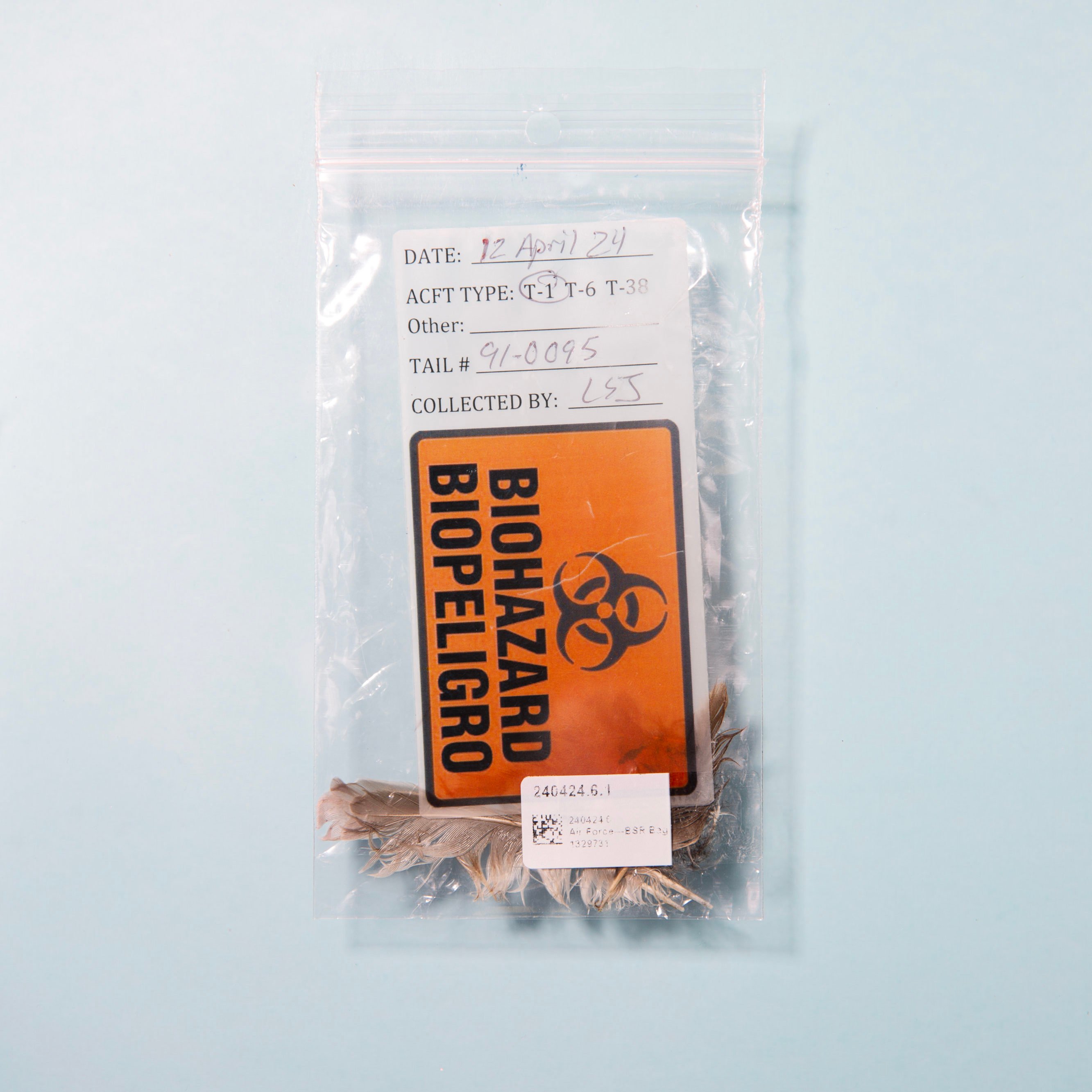
Back in the lab, Dove opens plastic bag containing three distinct feathers, each colored a shade of brown. The faintest aroma of jet fuel wafts over us as she picks up a white sheet of paper, the strike report mailed in with these remains. A Boeing 737 smashed anywhere from two to ten birds coming into Missouri. Dove and Jim Whatton, the lab’s deputy director, are sure that two of the feathers belong to a Canada goose, the cadaverous bird pulled from the library that’s lying before us.
The first thing to understand about bird-on-plane collisions? They’re not the animals’ fault. Swaths of open green space and very few people around make airstrips and their surroundings ideal places for the feathered to, well, flock. As a result, most bird strikes occur during takeoffs and landings. Even off-airport strikes—such as the one involving Sully’s plane—usually happen within five miles of an airport, and at an altitude of 3,000 feet or less.
With 45,000 flights crisscrossing the US every day, odds are good that a handful of airplanes will run into birds. In 1905, Wilbur Wright recorded the first-ever bird strike, over an Ohio cornfield. In 2023, planes hit more than 18,000 birds. The strikes cost the commercial aviation industry roughly $600 million annually in repairs—and if you add in military flights, the total is closer to $650 million.
Of course, not every collision results in plane damage, and relatively few cause crashes. “I would say most of the time pilots don’t even know they hit a bird,” Whatton says. But some impacts are catastrophic. In 1960, an Eastern Airlines flight leaving Logan Airport went down in Boston Harbor, killing 62 people. Investigators found bird carcasses at the end of the runway and feathers in the plane’s engines. They sent the remains to DC, where Laybourne identified them as European starlings. Federal safety regulators began asking airlines and airports to mail bird-strike reports, along with feathers and other remains, to Laybourne for identification.
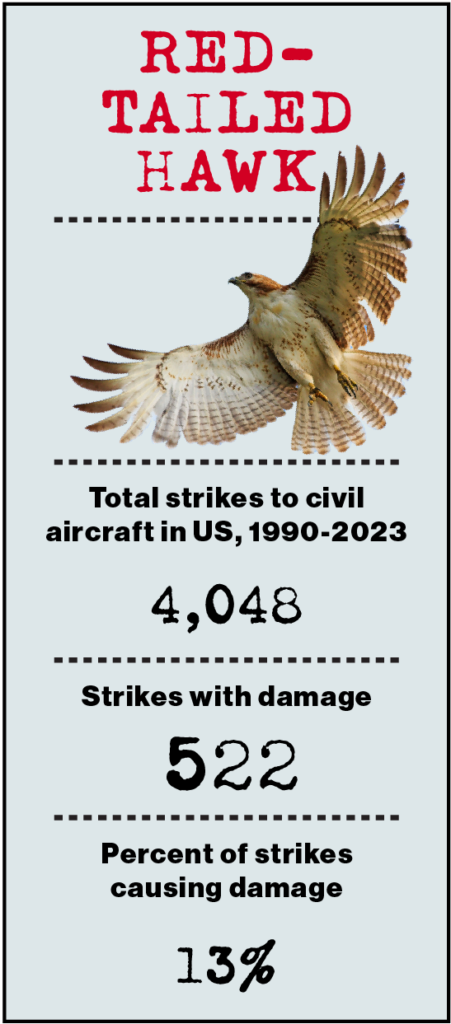
Today Dove’s lab inspects around 11,000 dead birds a year. After Sully’s plane hit the water, federal investigators sent in 69 bagged samples. Sometimes the remnants are relatively whole: a carcass, large bone fragments, a severed head. Sometimes they’re just snarge, which must be carefully wiped from fuselages, wings, and the inside of engines using paper towels or alcohol wipes to preserve bird DNA.
As with most detective work, identifying birds is both art and science. Largely intact samples can often be matched to corpses in the Smithsonian’s library. When bird leftovers are particularly gooey, they’re analyzed by DNA-sequencing machines that the Museum of Natural History keeps in-house. Tissue samples are prepared as slides and placed under a microscope, where Dove’s team looks for minuscule details that can help them make a match with samples from the collection.
Feathers are another clue, and the one the lab has been using the longest. With one of the feathers from the 737 strike in hand, Dove places it against the underbelly of the Canada-goose cadaver from the library. It’s a perfect match—so much so that it’s hard to distinguish between the mailed-in feathers and those still on the dead goose.
This work plays a crucial role in air safety. Identifying specific species—such as European starlings, sometimes called “feathered bullets” because their dense bodies make them more damaging—helps aircraft makers design engines, fuselages, and windshields that can better withstand collisions. It also lets them know how their current designs are holding up in the skies.
The engines on Sully’s plane were rated to withstand a run-in with most species of birds. When the plane ditched in the Hudson, there was initial worry that the engines were actually more vulnerable to strikes than anyone knew. After Dove’s lab pegged Canada geese as the culprit, the industry breathed a sigh of relief. Canada geese are eight-pound birds, too hefty to fully design around. The best way to prevent accidents involving them is to avoid striking them in the first place.
That’s where airports come in. Over the last three decades, the Federal Aviation Administration has recorded every reported midair encounter between bird and plane—roughly 285,000—in the National Wildlife Strike Database. Somewhat amazingly, just 651 bird species have ever been involved. Knowing the specific types of birds that are in their skies helps airports keep them from the flight paths of jumbo jets.
Take New York’s John F. Kennedy International Airport, which in the late 1980s was having problems with a population of nearby laughing gulls colliding with departing planes. Federal wildlife experts armed with shotguns were tasked with firing on the gulls. In 1990, there were 136 recorded incidents involving them. A year later, that number dropped to 60. Today there are fewer than seven gull strikes a year at JFK.
Dove is quick to note that solutions are not “one size fits all.” In 2003, an American Airlines flight leaving LaGuardia struck five Canada geese at 125 feet—knocking out an engine and sending one of its fan blades through the fuselage. While no one was injured and the plane landed safely at JFK, the question remained: What to do about the geese?
Inspecting the mangled remains, Dove’s lab made a crucial discovery: The geese involved were not from New York. They were migratory birds and couldn’t be controlled by airport workers. A euthanization program was launched: During the midsummer molting season, when geese are flightless for about two weeks, hundreds were rounded up and taken away. In the three-year period before the roundup began, there were nine geese strikes at LaGuardia. In the 20 years since, there have been a grand total of five.

Richard Dolbeer, an ornithologist and science adviser within the Department of Agriculture’s Airport Wildlife Hazards Program, helped create the FAA strike database. “So many strikes, particularly ones that cause major damage, the bird is pretty much annihilated and all that’s left is snarge,” he says. “If we didn’t have Carla identifying those strikes with certainty, then our database would be much less useful.”
Since 2000, the Wildlife Hazards Program has deployed 160 wildlife biologists to domestic and military airports nationwide. “One of the chief things we’re trying to do is change the habitat at the airport so that those bird species don’t want to be there anymore,” says Mike Begier, the program’s national coordinator. Different species require different tactics. For Canada geese—which have caused the highest number of damaging strikes to civil aircraft since database recording began in 1990—it’s advisable to shear airfield grass to minimum height. After all, geese are essentially flying cows. Chop the grass and you’ve just ruined their dinner.
By contrast, red-tailed hawks fly over airports to chomp on mice—if you spot hawks overhead, you implement rodent control. Bald eagles are a particular nuisance at Reagan National. After fishing in the Potomac River, they often land on the airfield, confident that their unobstructed views will allow them to spot any threats before tucking into their meals. To deal with them, the airport uses scare tactics: whistling noisemakers, fireworks-like pyrotechnics, and even good old-fashioned human hollering.
“Every bird has different behaviors and feeding habits,” Dolbeer says. “You really have to manage things based on what species are there.”
Feather number three from the Boeing 737 collision over Missouri takes a little more time to check. I wait as Dove retrieves another goose corpse from the library. To my untrained eye, it looks like the same Canada goose we’ve been inspecting. Then Dove picks it up and points at the beak, which is noticeably smaller. Its body is also much more compact.
This is a cackling goose. Sometimes cackling and Canada will fly in the same flock. Dove holds the final feather against the underbelly of each bird—another match with the dead Canada goose. As we step away from the table, I ask Dove what she thinks we would lose if her lab didn’t exist. She doesn’t miss a beat.
“The number of damaging bird strikes has decreased,” she says. “But the number of strikes is only going to rise as more people fly and more types of vehicles enter the air.”
No matter what airports do to limit strikes, larger jets are only going to get quieter and faster, making it harder for birds to recognize their threat. Meanwhile, a future of low-altitude delivery drones, helicopters traversing city skylines, and even flying cars promises additional collisions. As long as we fly, there will be snarge—and a need for people like Dove to inspect the feathers and the guts of pulverized birds, all so we can more safely share the sky.
Photograph of goose by Unsplash.
Photograph of hawk by Christopher McNeill/Getty Images.
Photograph of eagle by Mathew Schwartz/Unsplash.
Data provided by R. Dolbeer from FAA National Wildlife Strike Database
This article appears in the June 2024 issue of Washingtonian.
It Was Late Afternoon,
Carla Dove recalls, when the lines on her telephone “started lighting up like Christmas trees.” Coworkers barged into Dove’s office on the sixth floor of the National Museum of Natural History, breathlessly reporting the news: A passenger airplane had gone down into the Hudson River in New York.
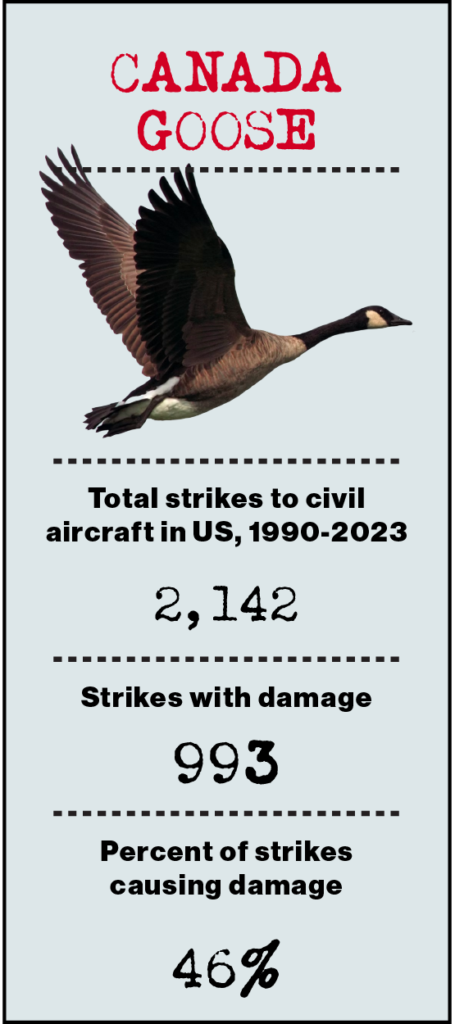
The date was January 15, 2009. As the world would later learn, a flock of birds had flown into the engines of a US Airways flight taking off from LaGuardia Airport, causing them to lose power. What happened next eventually became the basis of a Hollywood movie: Captain Chesley “Sully” Sullenberger and his copilot, Jeffrey Skiles, skillfully glided the Airbus A320 to a hard landing in the Hudson River. Everyone onboard survived.
Dove’s work was just beginning. A forensic ornithologist, she heads the Smithsonian Institution’s Feather Identification Lab, an elite, five-person unit that’s the only full-time bird-strike identification lab in the world. (Yes, her surname is Dove. Yes, she studies birds. Yes, she has already heard the joke.) Whenever birds collide with civilian or military aircraft so violently that what remains of the winged creatures is beyond recognition, Dove’s lab gets a call. The leftover gunk—feather residue, broken beaks, gut matter—is collected, then mailed to Washington. “We get degraded samples that are sometimes disgusting,” Dove says. “It’s not a very glamorous job.”
It is, however, essential. Tucked into a part of the Smithsonian that visitors usually don’t see, the domain of researchers, lab techs, and specimens kept in storage, the feather lab uses everything from DNA analysis to old-fashioned eyeballing to determine the particular species of bird remains. This isn’t simply an academic exercise. Between 1988 and 2023, wildlife strikes—the vast majority of them birds—destroyed 350 civil and military planes and killed 491 people worldwide. By figuring out which birds are most often involved, Dove and her colleagues are helping save lives—human and avian.
“Knowing what bird species are on an airfield,” she says, “is the first step in preventing these strikes from happening.”
On a Friday afternoon in March, I’m standing at a workspace in the Feather ID Lab. In front of us is a goose corpse—wings tucked in, beak tightly closed, its plump belly facing the ceiling. There are also several bags of what Dove and company call “snarge,” a mash-up of the words “snot” and “garbage,” used to describe the viscid leftovers of birds that have collided with planes.
A short woman with gray hair the shade of Meryl Streep’s, the 62-year-old Dove radiates authority and a reassuring warmth—she comes across like a favorite aunt who won’t tell on you if you admit to breaking a lamp in the house. Bird residue was not always her forte. She grew up in the Shenandoah Valley as the child of poultry farmers but usually ran for the hills when her grandmother, a woman who butchered her own chickens, busted out the cleaver.
“I wasn’t squeamish,” Dove says, speaking with a slight country twang. “Just being on a farm, you see how animals are butchered and prepared for food, but I didn’t want anything to do with it.”
Dove was the first person in her family to attend college, and later earned a master’s and a doctorate from George Mason University, where she studied the microscopic structures of feathers. As an undergraduate at Lord Fairfax Community College (now named Laurel Ridge), she studied under western Virginia naturalist Rob Simpson, who inspired her budding love of ornithology. “As a kid, I loved to watch vultures soaring around,” says Dove. “I was in tune with birds.”

After transferring to the University of Montana, Dove landed a work-study job at a zoological museum on campus, where she finally learned how to skin a bird. For her first attempt, she picked a cedar waxwing, which has a black mask, a crest of light-brown plumage, and just a touch of yellow on its belly. Things went poorly. “You don’t have to make them look alive, but you do have to make them look clean and functional,” Dove recalls. “And my bird turned out looking like a wet piece of ick. It was like a wet rag laying on the table, and I was just so embarrassed.”
By the time Dove graduated in 1986, she was no longer turning out wet rags. She moved home and found a job at a cancer-research lab in Bethesda but kept applying for jobs at the Smithsonian, until the Museum of Natural History hired her in 1989. That’s when she met the late Roxie Laybourne.
A Smithsonian ornithologist, Laybourne essentially founded the field of forensic ornithology—that is, using bird-feather identification to further conservation efforts, build cases against smugglers and poachers, and even prosecute homicides. (In one case, Laybourne matched feathers from a victim’s down jacket to those found in the perpetrator’s van. In another, she matched feather fragments found on a bullet removed from a victim’s body with fragments from their spouse’s pillow, which had been used to muffle the sound of the gunshot.)
To Dove, Laybourne was more than a brilliant, pioneering scientist. She was a career-shaping mentor and friend. Originally from North Carolina, Laybourne was a fellow “Southern girl,” as Dove says, who shared a similar passion for the outdoors—and a smattering of other, more random interests. “We had a lot of fun together because we had a lot of stuff in common. She liked to drive fast; I like to drive fast. We both liked to drink Mountain Dews and eat cheese crackers,” Dove says with a chuckle. “And we both just loved working here and solving puzzles.”
First working for Laybourne as a technician, Dove spent her daytime hours preparing specimens and cataloging birds, then stayed late into the evening and came in on weekends to learn more about identifying them. Eventually, she took over the lab. Dove also contributed to the growth of the Smithsonian’s bird library, which currently contains 500,000 preserved bird corpses, spread across 2,400 slim filing cabinets and representing 8,500 species.
Accounting for approximately 85 percent of the world’s diversity of birds, the library is a scientific marvel, routinely visited by researchers. But as more and more airplanes crowd our skies—striking an increasing number of birds—it has become something else: an indispensable tool.

Back in the lab, Dove opens plastic bag containing three distinct feathers, each colored a shade of brown. The faintest aroma of jet fuel wafts over us as she picks up a white sheet of paper, the strike report mailed in with these remains. A Boeing 737 smashed anywhere from two to ten birds coming into Missouri. Dove and Jim Whatton, the lab’s deputy director, are sure that two of the feathers belong to a Canada goose, the cadaverous bird pulled from the library that’s lying before us.
The first thing to understand about bird-on-plane collisions? They’re not the animals’ fault. Swaths of open green space and very few people around make airstrips and their surroundings ideal places for the feathered to, well, flock. As a result, most bird strikes occur during takeoffs and landings. Even off-airport strikes—such as the one involving Sully’s plane—usually happen within five miles of an airport, and at an altitude of 3,000 feet or less.
With 45,000 flights crisscrossing the US every day, odds are good that a handful of airplanes will run into birds. In 1905, Wilbur Wright recorded the first-ever bird strike, over an Ohio cornfield. In 2023, planes hit more than 18,000 birds. The strikes cost the commercial aviation industry roughly $600 million annually in repairs—and if you add in military flights, the total is closer to $650 million.
Of course, not every collision results in plane damage, and relatively few cause crashes. “I would say most of the time pilots don’t even know they hit a bird,” Whatton says. But some impacts are catastrophic. In 1960, an Eastern Airlines flight leaving Logan Airport went down in Boston Harbor, killing 62 people. Investigators found bird carcasses at the end of the runway and feathers in the plane’s engines. They sent the remains to DC, where Laybourne identified them as European starlings. Federal safety regulators began asking airlines and airports to mail bird-strike reports, along with feathers and other remains, to Laybourne for identification.
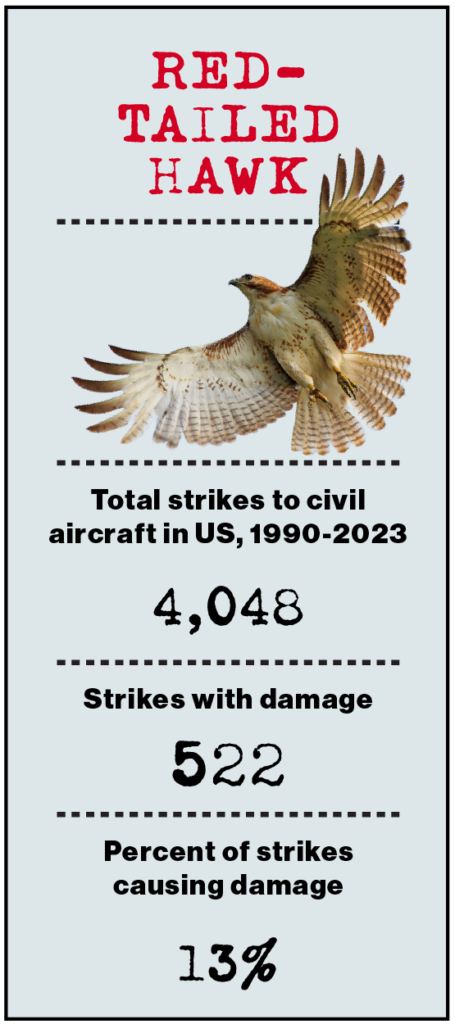
Today Dove’s lab inspects around 11,000 dead birds a year. After Sully’s plane hit the water, federal investigators sent in 69 bagged samples. Sometimes the remnants are relatively whole: a carcass, large bone fragments, a severed head. Sometimes they’re just snarge, which must be carefully wiped from fuselages, wings, and the inside of engines using paper towels or alcohol wipes to preserve bird DNA.
As with most detective work, identifying birds is both art and science. Largely intact samples can often be matched to corpses in the Smithsonian’s library. When bird leftovers are particularly gooey, they’re analyzed by DNA-sequencing machines that the Museum of Natural History keeps in-house. Tissue samples are prepared as slides and placed under a microscope, where Dove’s team looks for minuscule details that can help them make a match with samples from the collection.
Feathers are another clue, and the one the lab has been using the longest. With one of the feathers from the 737 strike in hand, Dove places it against the underbelly of the Canada-goose cadaver from the library. It’s a perfect match—so much so that it’s hard to distinguish between the mailed-in feathers and those still on the dead goose.
This work plays a crucial role in air safety. Identifying specific species—such as European starlings, sometimes called “feathered bullets” because their dense bodies make them more damaging—helps aircraft makers design engines, fuselages, and windshields that can better withstand collisions. It also lets them know how their current designs are holding up in the skies.
The engines on Sully’s plane were rated to withstand a run-in with most species of birds. When the plane ditched in the Hudson, there was initial worry that the engines were actually more vulnerable to strikes than anyone knew. After Dove’s lab pegged Canada geese as the culprit, the industry breathed a sigh of relief. Canada geese are eight-pound birds, too hefty to fully design around. The best way to prevent accidents involving them is to avoid striking them in the first place.
That’s where airports come in. Over the last three decades, the Federal Aviation Administration has recorded every reported midair encounter between bird and plane—roughly 285,000—in the National Wildlife Strike Database. Somewhat amazingly, just 651 bird species have ever been involved. Knowing the specific types of birds that are in their skies helps airports keep them from the flight paths of jumbo jets.
Take New York’s John F. Kennedy International Airport, which in the late 1980s was having problems with a population of nearby laughing gulls colliding with departing planes. Federal wildlife experts armed with shotguns were tasked with firing on the gulls. In 1990, there were 136 recorded incidents involving them. A year later, that number dropped to 60. Today there are fewer than seven gull strikes a year at JFK.
Dove is quick to note that solutions are not “one size fits all.” In 2003, an American Airlines flight leaving LaGuardia struck five Canada geese at 125 feet—knocking out an engine and sending one of its fan blades through the fuselage. While no one was injured and the plane landed safely at JFK, the question remained: What to do about the geese?
Inspecting the mangled remains, Dove’s lab made a crucial discovery: The geese involved were not from New York. They were migratory birds and couldn’t be controlled by airport workers. A euthanization program was launched: During the midsummer molting season, when geese are flightless for about two weeks, hundreds were rounded up and taken away. In the three-year period before the roundup began, there were nine geese strikes at LaGuardia. In the 20 years since, there have been a grand total of five.

Richard Dolbeer, an ornithologist and science adviser within the Department of Agriculture’s Airport Wildlife Hazards Program, helped create the FAA strike database. “So many strikes, particularly ones that cause major damage, the bird is pretty much annihilated and all that’s left is snarge,” he says. “If we didn’t have Carla identifying those strikes with certainty, then our database would be much less useful.”
Since 2000, the Wildlife Hazards Program has deployed 160 wildlife biologists to domestic and military airports nationwide. “One of the chief things we’re trying to do is change the habitat at the airport so that those bird species don’t want to be there anymore,” says Mike Begier, the program’s national coordinator. Different species require different tactics. For Canada geese—which have caused the highest number of damaging strikes to civil aircraft since database recording began in 1990—it’s advisable to shear airfield grass to minimum height. After all, geese are essentially flying cows. Chop the grass and you’ve just ruined their dinner.
By contrast, red-tailed hawks fly over airports to chomp on mice—if you spot hawks overhead, you implement rodent control. Bald eagles are a particular nuisance at Reagan National. After fishing in the Potomac River, they often land on the airfield, confident that their unobstructed views will allow them to spot any threats before tucking into their meals. To deal with them, the airport uses scare tactics: whistling noisemakers, fireworks-like pyrotechnics, and even good old-fashioned human hollering.
“Every bird has different behaviors and feeding habits,” Dolbeer says. “You really have to manage things based on what species are there.”
Feather number three from the Boeing 737 collision over Missouri takes a little more time to check. I wait as Dove retrieves another goose corpse from the library. To my untrained eye, it looks like the same Canada goose we’ve been inspecting. Then Dove picks it up and points at the beak, which is noticeably smaller. Its body is also much more compact.
This is a cackling goose. Sometimes cackling and Canada will fly in the same flock. Dove holds the final feather against the underbelly of each bird—another match with the dead Canada goose. As we step away from the table, I ask Dove what she thinks we would lose if her lab didn’t exist. She doesn’t miss a beat.
“The number of damaging bird strikes has decreased,” she says. “But the number of strikes is only going to rise as more people fly and more types of vehicles enter the air.”
No matter what airports do to limit strikes, larger jets are only going to get quieter and faster, making it harder for birds to recognize their threat. Meanwhile, a future of low-altitude delivery drones, helicopters traversing city skylines, and even flying cars promises additional collisions. As long as we fly, there will be snarge—and a need for people like Dove to inspect the feathers and the guts of pulverized birds, all so we can more safely share the sky.
Photograph of goose by Unsplash.
Photograph of hawk by Christopher McNeill/Getty Images.
Photograph of eagle by Mathew Schwartz/Unsplash.
Data provided by R. Dolbeer from FAA National Wildlife Strike Database
This article appears in the June 2024 issue of Washingtonian.






